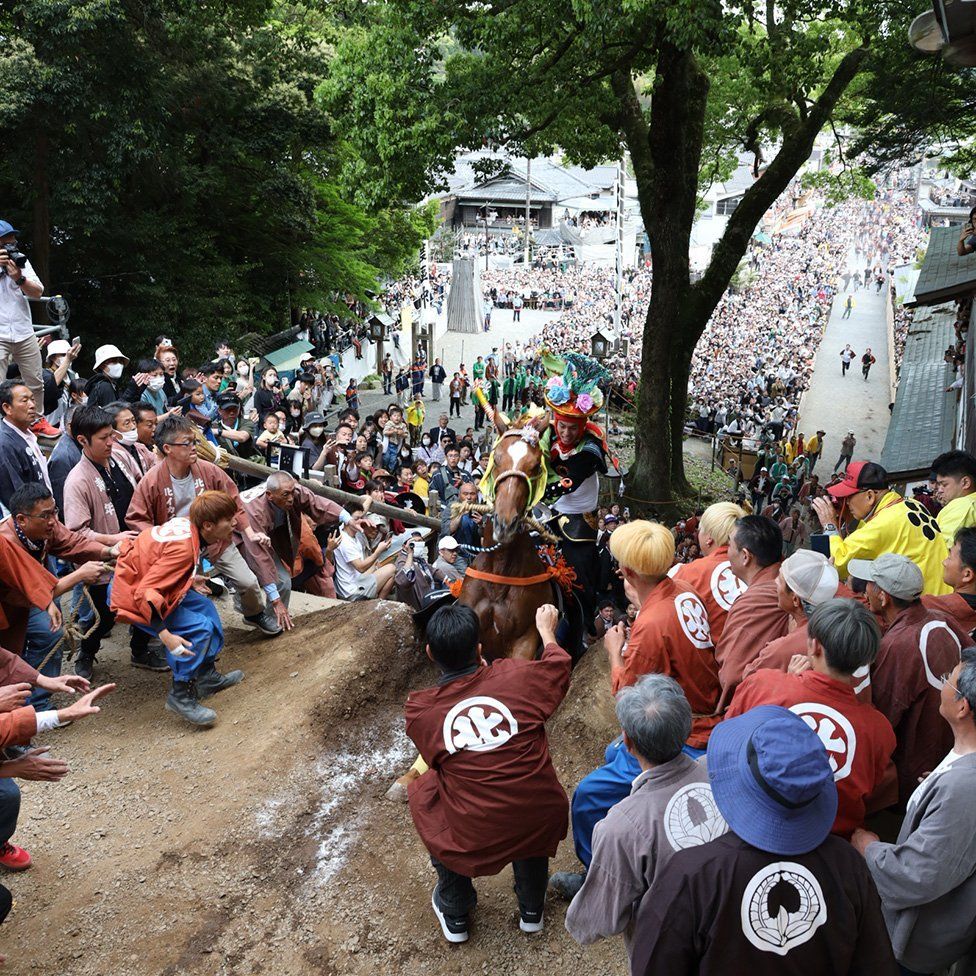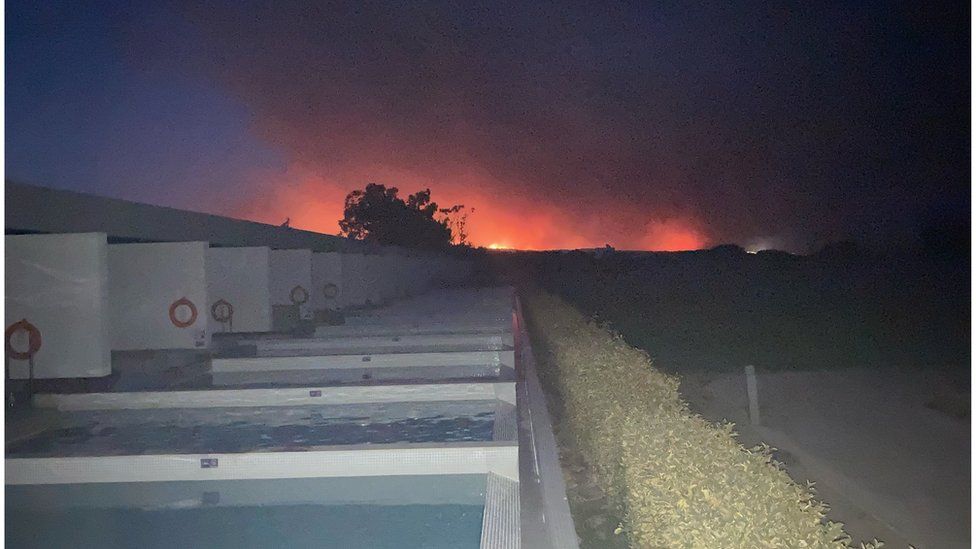A popular Shinto festival in a Japanese mountain town came under fire after a horse died and accusations of animal cruelty surfaced. Now that reforms have been promised by the authorities, can this 680-year-old event change sufficiently to ensure its future?
The crowds applaud as a young rider gallops quickly up a challenging hill while dressed as an ancient Japanese warrior. They have to jump over a head-high mud wall as they are directly in their path.
Numerous men, holding hands and chanting, line the last, narrow area below the wall. They must assist the horse and rider from their district in getting over the wall because it is believed that every horse that does so will bring good luck to the harvest.
However, as the horse's legs start to flail, it becomes stuck on its back and must be pulled over the wall by shrine patrons using ropes.
Another dramatic incident that was captured on video features a horse slamming its lower jaw into the mud wall, sending both the rider and the horse tumbling backwards.
Over the course of the two festival days, the majority of the 18 horses that participate fall short of the nearly impossible challenge.
Social media users expressed their sorrow after one horse had to be put down after sliding down the hill and breaking its left leg. Along with one rider, five other horses suffered injuries.
Up until this year, the festival was regarded as the cultural crown jewel of central Japan's Mie Prefecture.
Ageuma Shinji, also known as the Rising Horses festival, was designated as "an intangible cultural asset" by Mie's education board 45 years ago. It is typically held on May 4 and 5.
But it appears that the public's attitude has changed after the pandemic's three-year break.
A festival-related tweet sparked a social media backlash, and the prefecture received 1,000 complaints as a result. Over 31,000 people signed a petition calling for the rite to be abolished, and the topic was even brought up in the Japanese parliament.
In a victory for the campaigners, the prefectural government has now disclosed it will review the slope and structure of the wall in light of concerns about animal welfare.
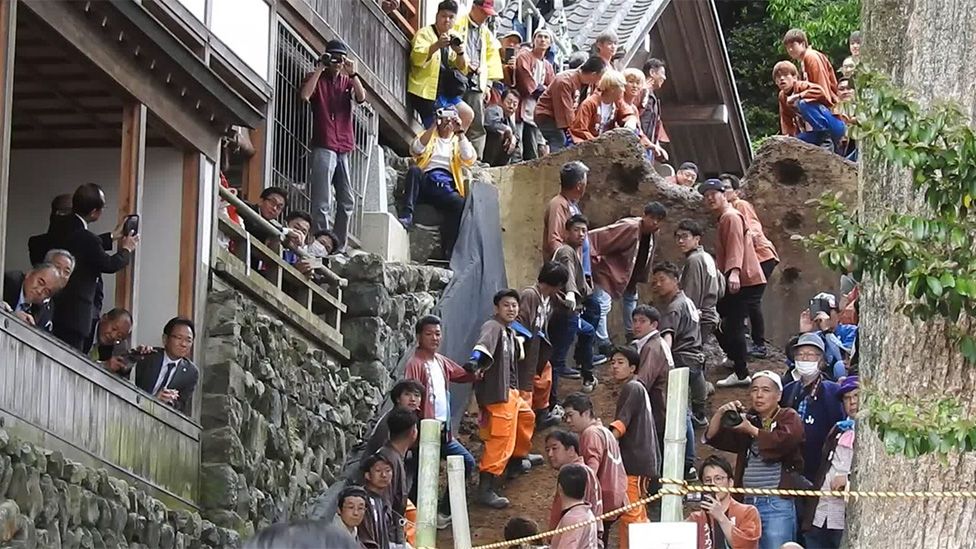
The route is difficult; following a straight run down a road, the horses must climb a steep hill and then jump over a high wall.
The wall at Ageuma, which stands at 1.70m (5ft 7in), is 13cm (5in) taller than the highest jump at the contentious Grand National race in the UK, where three horses died this year. Additionally, it exceeds the 1.60m (5ft 3in) height restriction for show jumping set by the International Federation for Equestrian Sports.
A horse would need to gain a lot of momentum in order to jump over such a tall object, according to Dene Stansall, a horse expert who consults the UK charity Animal Aid. However, he believes that the horse's full speed cannot be reached in the 200m (656 ft) run-up.
He says the hill makes it more difficult because very few horses will actually make it to the top because "their stride changes dramatically" when they go up an incline.
According to a Tado Taisha spokesperson, the festival is an old Shinto ritual that dates back to the Nanbokucho Period (1337–1392) and is held at the shrine in Kuwana, 100 kilometers (62 miles) east of Kyoto.
But it's not clear when the hill sprint actually started. The first instance of proof the prefecture cites is a mention of "riding up the hill" in 1794, but a wall isn't mentioned until 1938. 1951 saw the release of the first piece of film evidence.
The director of the environmental group Life Investigation Agency (LIA), Ren Yabuki, believes that if farmers still relied on their horses for their livelihood, they would not have subjected them to such a hardship. .
There is no way they would act in a way that would harm people, he asserts. They would forfeit their belongings. ".
The haziness surrounding the dates supports the claim made by animal rights activists that the wall sprint is not an old custom but rather one that was created more recently to draw more people to the shrine.
According to Mie Prefecture, four horses have perished at Ageuma over the past 15 years.
Dr. Koichi Aoki, a veterinarian with the Japanese Coalition for Animal Welfare, has been working for 21 years to improve the conditions for horses at Ageuma by lowering the wall and slope.
There have been three formal complaints made to the police during that time, but no cases have been prosecuted. One complaint was rejected because at the time "beating" and "kicking" were not regarded as forms of animal abuse.
However, Japan's animal welfare laws were expanded in 2020 to include the crime of "forcing an animal to overwork," which, in Dr. Aoki's opinion, means that the uphill sprint counts as abuse.
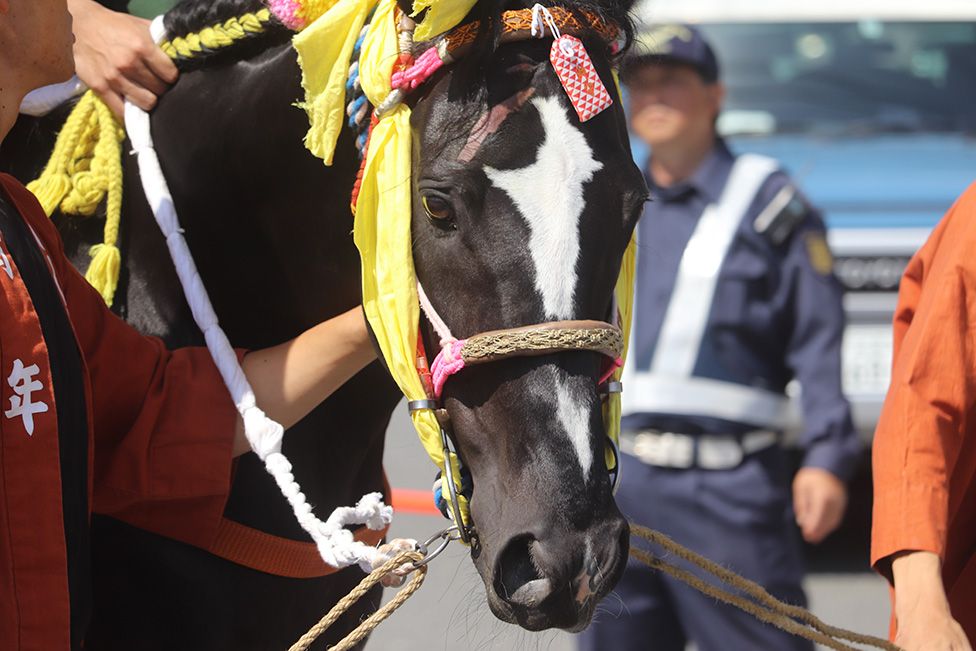
He has hope that this could be the year when things start to change because, in Dr. Aoki's opinion, the social media campaign has had a significant effect. "Up until this point, only we demanded changes. But all of a sudden, people understood the true nature of the festival," he claims.
Campaigner known only as mihomi*, who attended the festival this year, claims that if the event is not traditional, it is simply animal entertainment disguising itself as a Shinto ritual.
She expressed surprise at the spectators' ostensible lack of concern for the horses to the BBC.
The horses crashed into the walls and tumbled down the hill, and locals, young and old, men and women, cheered and shouted for joy and sorrow as they did, she claims.
Instead of saying, "Poor thing," the kids were saying, "Good luck" to the horse that had fallen and was in pain. Behind me, a local person said, "I think I'll name my grandchild after the next successful horse.". '".
Mihomi* realized it would be hard to change local attitudes after witnessing the intense pride the locals had in their community.
But when they learned a horse had broken its leg and been put down, even festival attendees who were present that day expressed shock.
Social media users posted a picture of the injured horse along with the suggestion that the festival might need to be reconsidered.
Local rice distributor is the owner of the deceased horse. He released a statement expressing regret for the death after facing backlash on social media.
He asserted that the horse, formerly known by the racing name Merzouga, had not been mistreated and that it had been euthanized in accordance with legal requirements and the veterinarian's recommendation.
He claimed that for 20 years, without incident, he had participated in the festival "out of a sense of responsibility and for the sake of tradition.".
"I have been a member of the Ageuma shrine since I was a child, and it has been a part of my life and a source of pride for me," the statement read. It is getting harder to transmit the skills, culture, and traditions associated with the rituals because there are fewer young people participating each year. ".
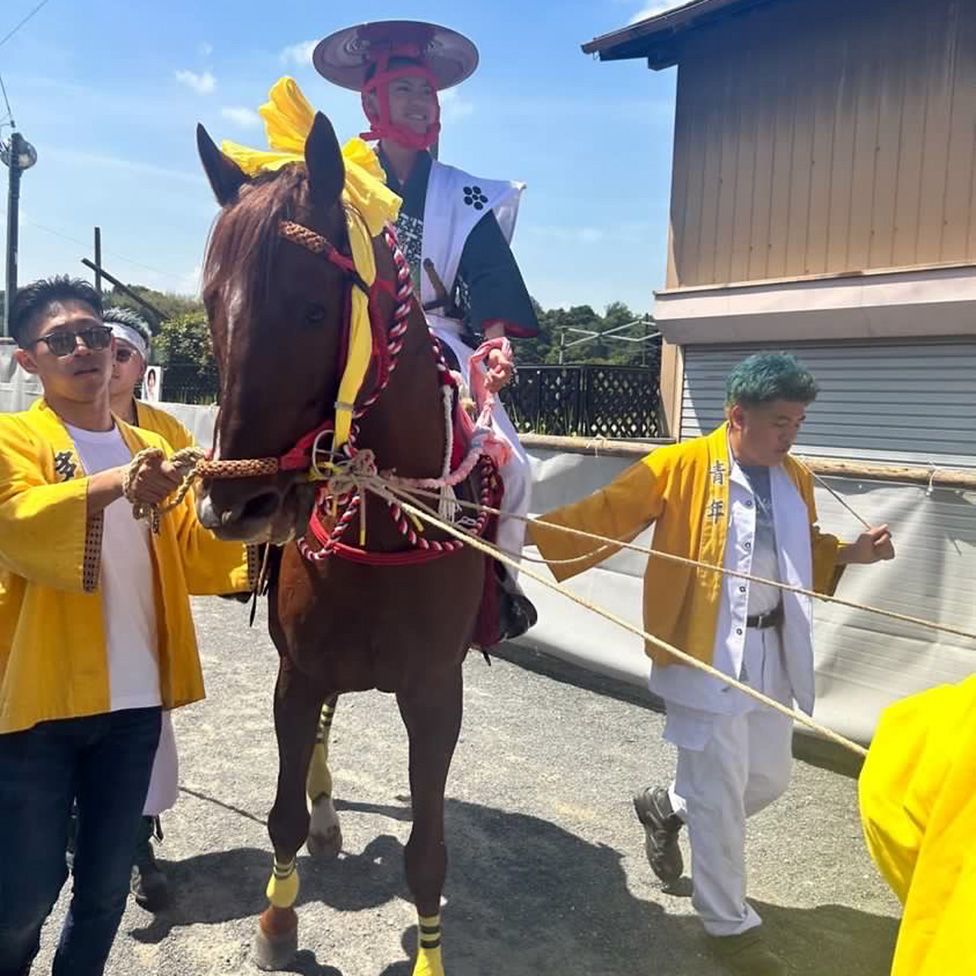
The owner and his family, according to the statement, had received numerous "angry and scolding messages," but they had been unable to respond because they had been "in an unstable mental state" ever since the accident.
The use of retired racehorses like Merzouga worries activists because thoroughbreds are even less suited to the terrain than earlier, smaller Japanese horse breeds. However, it's now uncommon to see native horses.
"One of the problems with racehorses is that they're very fragile animals," says horse expert Mr Stansall. Because of their light skeleton and powerful muscles, which allow them to run so quickly, they are more likely to break limbs.
Thoroughbred horses are no longer permitted to compete in the Palio di Siena, an Italian race with medieval roots that draws thousands of tourists every summer, according to Sonny Richichi of the nonprofit Italian Horse Protection. This is because they frequently had serious accidents.
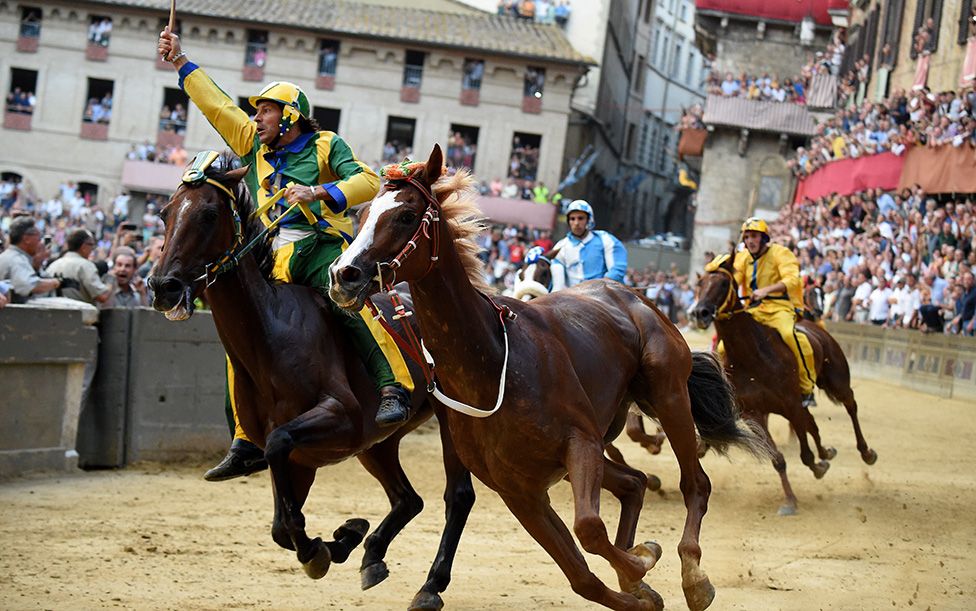
Although direct comparisons between the competitions are difficult to draw, the Grand National and the Palio both saw more horse fatalities than Ageuma in the previous 15 years.
Jumping is more dangerous though - Mr Stansall suggests that three horses die when jumping over obstacles for every one horse that dies running on flat ground.
However, he thinks that the danger is part of the attraction at such events. "It's about the failure as much as the success - the spectacle of horses falling and going down on the ground. ".
The environmental group LIA has this year submitted a formal complaint about Ageuma to the police. Their investigator, Kaoru Nitta, scrutinised hours of footage and media reports, and found 118 instances of suspected abuse.
She shared the dossier with the BBC. It included multiple pictures of welts on horses' skin, which Ms Nitta believes were caused by the riders whipping them with bamboo sticks.
A spokesperson for the shrine explained that the riders follow ancient customs, and that using bamboo sticks was part of that.
Ms Nitta also witnessed spectators hitting the horses with their hands or with Happi coats - traditional short jackets worn at festivals.
The shrine said they had long tried to educate the public by distributing posters and flyers, and that it was "regrettable for us to be told that some people ignore our reminders". It added that it observed all the relevant laws and regulations and had doubled the number of inspectors at the festival.
"If you consider this is still happening even with official observers present, I can't imagine what it was like before," says Ms Nitta.
Mie Prefecture told us it wants to ensure that the Ageuma ritual is a safe event for both people and horses. In 2004, it established the Council for the Prevention of Cruelty to Horses which provides guidance and advice on the handling of horses. And in 2010, they prohibited spectators from coming into contact with the horses.
Initially the prefecture said some of the behaviour at this year's event was "inappropriate" but stopped short of calling it abuse.
However, following its yearly health and safety meeting, on 19 June the prefecture proposed changes to the festival that would be "acceptable to society based on the concept of animal welfare".
They announced that the entire structure of the hill, including the wall, would be reviewed and also promised to improve the way horses were handled.
But Ms Nitta thinks the height of the wall is not the only issue, and that there is no way the event can be conducted safely. She says horses find the noise, heat and crowds distressing, as well as the long days.
"The investigation showed that the environment of Ageuma itself is a very stressful place for horses to be, even before climbing over the wall or running up the hill," she says.
For now, the prefecture's proposal lacks detail, adds the LIA's director, Mr Yabuki. He hopes the ritual will one day not use animals at all.
And although she recognises the importance of the festival for the community, mihomi* says she will carry on fighting for change. .
"Even traditional events should be changed to suit modern ethics and social conventions," she says. .
All images subject to copyright .

